
What is the cause of plant root rot and its solution?
At times, we witness plants wilting inexplicably, their leaves beginning to yellow and shed. In these instances, some may assume the plant simply requires watering, overlooking the true culprit: root rot. Root rot poses a critical challenge for plants that demands swift intervention. Within this discourse, we intend to scrutinize the telltale signs of root rot in plants and elucidate strategies for its prevention. Furthermore, we should delve into the various treatment methodologies for combating plant root rot. Join us on this insightful journey.
What is Plant Root Rot?
Plant root rot is a damaging process where a plant’s roots soften and decay due to factors like excessive watering, fungal infections, and more. Root rot is noticeable in both houseplants and farm settings. This condition directly affects the plant’s nutrient uptake, leading to yellowing leaves, wilting stems, leaf deterioration, and ultimately plant demise.
Because plant roots are underground, symptoms of rot aren’t immediately visible in the early stages. We only become aware of root rot when visible changes occur in the plant’s appearance. As a result of rot, the plant’s roots shift from a firm to a soft texture and from a white or light color to a dark brown or black shade. Rotted roots easily disintegrate upon touch.
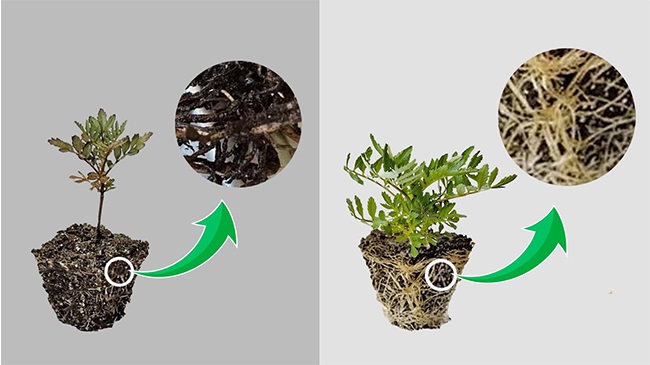
It’s worth noting that root rot is contagious among plants, meaning it can spread from one plant to another. The ideal conditions for root decay include warmth, dryness, and lack of oxygen. Therefore, excessive watering increases the risk of root rot.
What are the reasons?
Root rot in trees and plants happens for various reasons. Knowing the cause of root rot allows you to make informed decisions about treating it. The primary reasons for root rot include:
- Excess soil moisture: Overwatering and too much soil moisture are the main culprits behind plant root decay. Soggy soil prevents adequate oxygen from reaching the roots, leading to rot. During heavy rains and excessive watering, the soil becomes waterlogged, increasing the moisture around the roots and causing decay.
- Poor drainage: Sometimes, watering is sufficient, but poor soil drainage results in lingering moisture, causing root rot.
- Fungi: Fungi are common causes of root rot. Phytophthora and Armillaria are among the fungal factors contributing to plant root decay. When there’s a good balance of oxygen and water in the root area, fungal growth is minimal. However, when this balance is disrupted, fungal growth increases. Excessive moisture provides an environment for disease-causing fungi to thrive and spread.
- Excessive fertilizer use: Nitrogen-based fertilizers are essential for plant growth. While nitrogen fertilizer is crucial for plant growth and product quality, excessive use can harm the roots. It’s important not only to use nitrogen fertilizers but also all macro and micronutrients in the right amounts based on the plant’s requirements.
- Bacteria: Soil moisture and contamination are the primary drivers of bacterial growth. Bacteria can attack the roots, leading to root decay. Additionally, pests and other diseases can also play a role in root decay. Pests like mites, root weevils, and root-eating worms can cause significant damage to plant roots.
- Soil compaction: High soil density and poor drainage lead to soil compaction, disrupting oxygen flow. Lack of soil oxygen results in plant root decay. Unsuitable soil is another reason for inadequate oxygen circulation. We suggest you take a look at our guide to soften soil.
- Environmental stress: Unfavorable weather conditions, shade, insufficient or excessive light, and very high or low temperatures can all contribute to plant root rot.
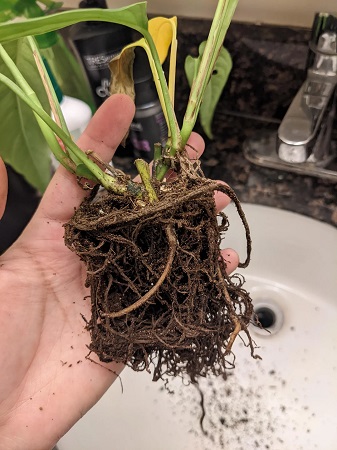
What are the signs?
In general, some symptoms of tree and plant root decay can be mistaken for plant dehydration and wilting. In these scenarios, misdiagnosis and rehydration can worsen the signs of decay. To identify root rot, you should extract the plant from the soil and examine the root condition. If the roots appear brown, emit a foul odor, and show decay, root rot has occurred. Conversely, if the roots are healthy and white, they are in good condition.
Visible indicators of root rot include:
- Yellowing and wilting of plant leaves
- Discoloration and wrinkling of stems
- Wilting and lack of vigor in the plant
- Stunted plant growth
- Unpleasant smell and foulness in the plant container (due to the presence of bacteria and contaminated fungi)
- Observation of fungi and mold in the soil
If you observe signs of root rot, remove the plant from the soil and examine its roots. If clear symptoms of root decay are present, take prompt remedial action.
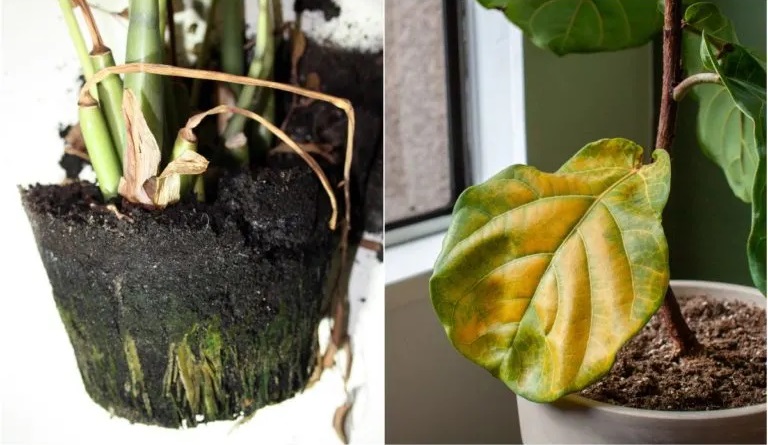
Preventive Measures
Plant decay is a gradual process. Decay spreads from damaged roots to healthy ones, causing more extensive parts of the plant’s root system to deteriorate. The most effective way to address root rot is through prevention.
There are several key methods to prevent root rot:
- Ensure the soil isn’t overly compact and has proper drainage.
- Employ modern irrigation techniques to avoid waterlogging.
- Establish a precise watering schedule.
- Using humic acid fertilizer can aid root growth and health, boosting plant resilience to environmental stress and preventing root decay.
- After watering potted plants, check and empty any excess water in the saucer.
- Planting on raised beds can help prevent root rot.
- Avoid excessive use of chemical fertilizers; apply fertilizers according to the plants’ requirements.
- Fungicides can be useful in preventing root rot by treating the soil to disinfect it and combat root decay.
- Regularly inspect your plants to catch any signs of root rot early and take prompt action to address it.
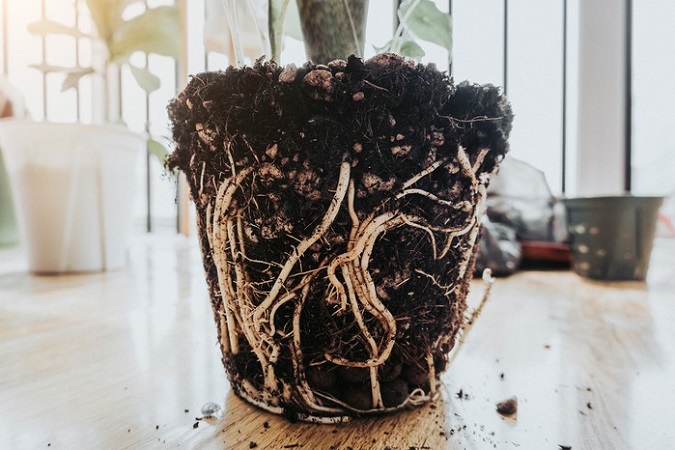
Strategies for Treating Root Rot in Indoor Plants
The best way to maintain the health of plants and trees is to prevent root rot. However, if it does occur and your plant is affected by rot, it’s best to address it in its early stages. When root rot is detected early on, there is a possibility of treatment.
Treating root rot in indoor plants heavily depends on the severity of the disease and the underlying cause. Sometimes, by cutting off irrigation and ensuring proper soil drainage, the issue can be controlled. In more severe cases, it may be necessary to trim away the rotted roots. To pinpoint the root of the problem, consulting with a specialist or a plant doctor is advisable.
Treating root rot in indoor plants is somewhat feasible. When severe signs of root rot are observed in these plants, it’s essential to remove the plant from its pot and examine the roots. Rotted roots are typically brownish-black in color, soft, and brittle. If the entire root system has turned black and mushy, treatment may not be possible. However, if you still see a few white, firm roots, there is a chance the plant can be saved.
Gently rinse the roots under water and separate any soil clinging to them. Then, trim away all infected and dead roots using clean shears. Ensure that you have removed all affected parts during cleaning. Any remaining infected root within the soil can lead to future spread. For replanting, discard the old soil completely and use clean soil to refill the pot.
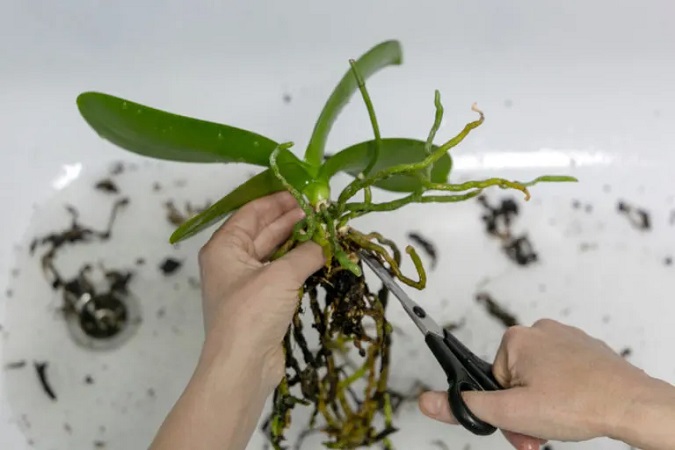
After planting a plant in a pot, it’s crucial to take two specific actions. Firstly, sterilize all the tools used with a sterilizing solution. Secondly, avoid overwatering and excessive fertilization. Excessive fertilization can lead to soil salinity, putting the plant’s health at risk.
Let’s go over the steps for treating root rot in indoor plants:
- Remove the plant from the soil.
- Separate the soil clinging to the roots.
- Carefully inspect the roots and trim the soft, brownish roots (rotted roots) using shears.
- Select a new pot with proper drainage.
- Fill the pot with suitable soil. (Do not transfer the soil from the previous pot where the roots were rotted. Ensure the soil has adequate drainage.)
- Use a fungicide to prevent future root rot. Begin by spraying the fungicide on the plant’s roots, then place the plant in the pot.
Treatment Strategies for Root Rot in Plants (in Gardens and Farms)
Dealing with root rot in garden and farm plants poses challenges, as uprooting each plant isn’t practical. When root rot affects an entire garden or a significant portion of plants, the situation becomes more intricate. In addressing root rot in garden plants, the first aspect to consider is the plant watering regimen. To hinder the progression of rot, especially if it’s not advanced, reducing watering and switching to drip irrigation can be effective. Additionally, utilizing humic acid fertilizers, which help balance soil pH and combat root fungal diseases, proves advantageous in controlling root rot.
In the battle against rot induced by fungi and bacteria, farmers turn to fungicides. The most effective fungicides for tree root rot include metalaxyl, fenoxaprop, and triazoles. Similarly, top fungicides for root rot comprise fenbuconazole, abamectin, and phosphites. When using fungicides to combat root rot, consulting with an agricultural expert is crucial to pinpoint the best fungicide tailored to the specific fungi surrounding the plant roots.
If root rot has significantly advanced, prompt removal of the plant from the soil is necessary. This step prevents the spread of rot to unaffected areas, safeguarding portions of the farm still free from root rot. Preserving healthy plant sections involves adjusting the watering routine, incorporating fungicides, and revising the soil fertilization plan.
